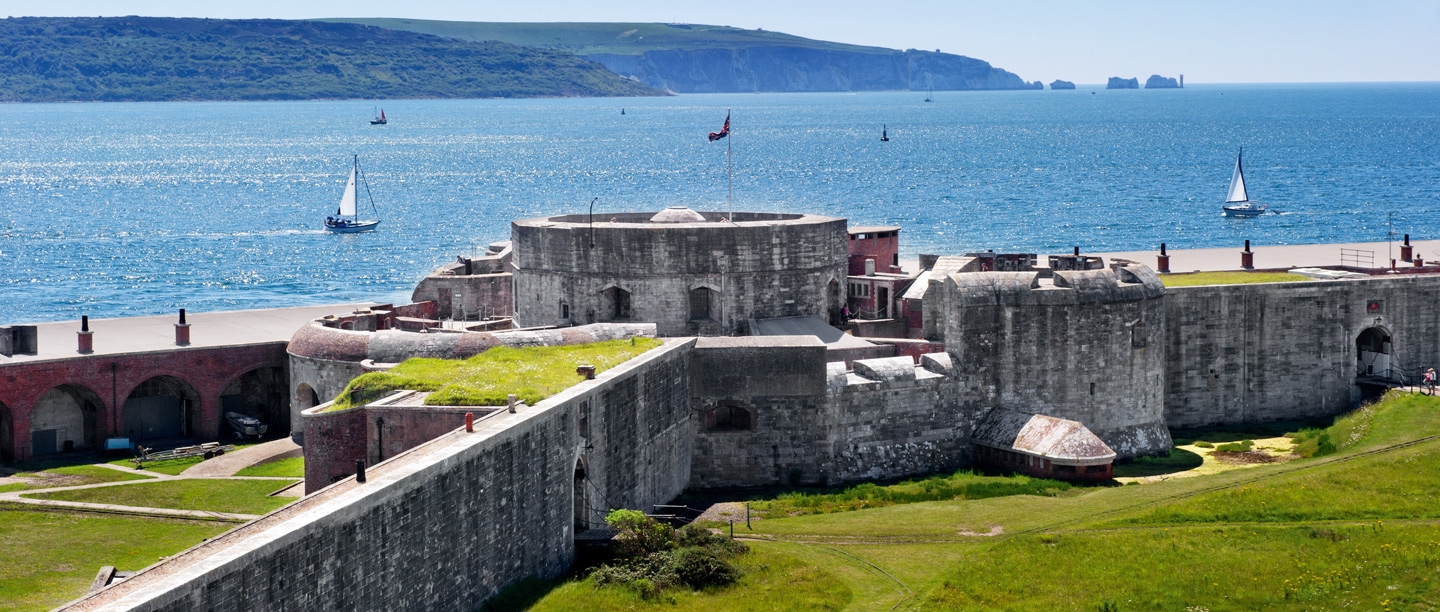Latest update
October 2022 has seen the next phase of conservation begin at Hurst Castle with work to strengthen the counterscarp wall in front of the south bastion, as well as geotechnical investigations taking place.
The counterscarp wall was initially built to define a shingle ditch in front of the castle’s keep, but due to coastal change, it now forms an important part of the sea defences. As part of English Heritage’s ongoing programme of work at Hurst Castle, the charity has commissioned repairs to strengthen the wall and help protect the castle from the impact of wave action, ahead of the winter storms.
With teams working tirelessly since the partial collapse at Hurst Castle in 2021, 22,000 tonnes of shingle and rock armour has been transported along the spit to protect the east wing and a permanent revetment sea defence engineered to provide protection for the next 50 years has been completed. As part of this next phase, English Heritage has commissioned specialist contractors Socotec UK to conduct extensive geotechnical investigations around the castle and on the spit itself.
These investigations will look into understanding the forces at work on this exposed shingle causeway and the geology under the castle, and is essential in informing the best course of action with regards to the future repair of the breach. A range of techniques will be employed (including Hand Digging, Cable Percussion, Rotary Coring, Trial Pitting and Concrete Coring) to assess the ground conditions under the east and west wing castle walls, looking at the structural integrity of the existing foundations.
We are grateful to The National Heritage Memorial Fund for their generous grant which has enabled this essential work to go ahead. The funding comes from the government’s Cultural Assets Fund, which has been distributed as part of the wider COVID-19 Respond Fund.
Whilst English Heritage is pleased to be able to proceed with this next stage, we must stress that there can be no quick fix to the complex issues facing the castle, from sea level rise to climate change. However, the conservation work and investigations we are conducting will prove invaluable for future protection of the historic structure.
Hurst Castle has been named to the 2022 World Monuments Watch, a selection of 25 heritage sites of worldwide significance whose preservation is urgent and vital to the communities surrounding them. These sites powerfully demonstrate pressing global challenges of climate change, imbalanced tourism, underrepresentation, and recovery from crisis, underscoring the need for greater action to support heritage places and the people who care for them. You can view the full list of 2022 Watch sites here.
View our statementProtecting Hurst Castle
Hurst Castle has been in the care of English Heritage and its predecessor the Ministry of Works since 1956, and during that time we have made a number of investments to protecting the castle and its sea defences.
In 2019, we undertook an extensive programme of works totalling £750,000 to stabilise the foundations of the west wing of the castle and to reinforce its sea defences. The charity underpinned the west wing’s foundations, replaced broken groynes and barriers, and replenished the beach with 7,500 tonnes of shingle.
Two years earlier, in 2017, English Heritage invested £1m in a major project to repair and conserve the castle’s roof.
Read about our 2017 projectHow the castle has changed throughout history
The central part of Hurst Castle was built between 1541 and 1544 by Henry VIII as part of a chain of artillery fortresses protecting key ports and landing places around southern England. The castle guarded the Needles Passage leading to the Solent, the port of Southampton and the growing naval base at Portsmouth. Hurst was also occasionally used as a prison – most famously when Charles I was held captive here in 1648.
The castle was greatly modernised in the 19th century, when it formed a key fortress protecting one of the world's most heavily defended areas. Unusually for a Tudor castle, it remained in military use until 1956, playing an active role through both world wars. The castle’s position on the spit has long made it vulnerable to the forces of the wind and waves. With changes in longshore drift, rising sea levels and more frequent storms, Hurst Castle is amongst the most challenging heritage sites to our care to protect, and emblematic of the issues posed by climate change to our heritage.
Visit our history pageA changing seascape
The castle is in an extremely vulnerable position. The shingle spit on which it sits formed naturally from loose flint pebbles as they eroded from the cliffs further west and were transported over the centuries as a result of the forces of wind and waves. With changes in longshore drift, rising sea levels and more frequent storms, the integrity of the spit has often been under pressure, and during a storm in 2014 100,000 tonnes of shingle were displaced overnight, reducing its height by 7m.
As a result of the pressures on the spit, Hurst Castle is amongst the most difficult heritage sites to protect in England, and the site is also at risk from climate change. Environment Agency data from nearby tidal gauges is already showing a net mean increase in sea levels, and estimates suggest that levels will rise in the area by 1m – 1.5m in the next 100 years. The area between Hurst Spit and Lymington is the subject of a large scale multi-agency flood and coastal erosion risk management strategy. As such, the coastal castle is emblematic of the huge challenge posed by climate change to our heritage.
Learn more about the Hurst Spit to Lymington project
